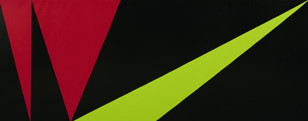Olle Bærtling
06 Oct 2007 - 06 Jan 2008
OLLE BÆRTLING
"A Modern Classic"
Olle Bærtling (1911-81) is one of the few Nordic artists of the second half of the 20th century who made a name for himself internationally. Initially inspired by the Concretists, he developed a style of his own with bright colours in triangular shapes, which, in his later works, appear to move out of the frames into the infinity of space, which has become the distinguishing characteristic of Bærtling. Today he is considered a modern classic.
Curator: John Peter Nilsson
Olle Bærtling (1911-1981) is unique in Swedish art history. He is regarded as one of Sweden’s most seminal postwar artists, and is one of the few to have an international reputation. He exhibited at the Sao Paolo Biennale in 1959, for instance, and has had 17 solo exhibitions in the USA.
Olle Bærtling was presented in a major show at Malmö Konsthall and Moderna Museet in 1981. Since then, a new generation of artists and designers has discovered his bold experiments in form and colour. His contradictory and challenging personality is also intriguing. Olle Bærtling worked as a banker until 1956, had no formal art education and hated Sweden’s twee “porridge” art.
He was a futuristic optimist with utopian visions, which came to expression in his avid interest in the urban space. One of the ideas he promoted was the founding a new capital on Hallandsåsen in southern Sweden, since Stockholm was too far from everything. His projects include the paintings in the entrance foyer of the first high-rise building at Hötorget in Stockholm, the embellishment of Stockholm University and Kulturhuset.
John Peter Nilsson, curator:
“Our social climate today is characterised by a defensive approach. We defend ourselves against everything – higher interest rates, disease and accusations. ‘Outraged’ is the word in fashion. Olle Bærtling’s art, on the contrary, exudes hope, vitality, optimism. We need that.”
Olle Bærtling was inspired by the new wave of non-figurative art that evolved especially in Paris in the late-1940s, early 1950s. From the second half of the 1950s and onwards, he developed his own characteristic style of painting, based on open triangular shapes that appear to extend beyond the canvas, into infinite space. This expansive, unbounded vision is redolent of American minimalism, a perspective that has previously been overlooked but is now one of the key elements of Moderna Museet’s new look at this artist. In 2008, the exhibition will also tour to the Chinati Foundation in Marfa, Texas, founded by Donald Judd.
In conjunction with the exhibition, Moderna Museet, Liljevalchs konsthall and ABF will jointly organise a series of seminars, Modernismen tur & retur (Modernism roundtrip). Arkitekturmuseet will feature an exhibition of designs by the architect David Helldén, friend and colleague of Olle Bærtling: Helldén + Bærtling = Aesthetic Space.
The exhibition is produced jointly by the curators John Peter Nilsson, Moderna Museet, and Øystein Ustvedt, Nasjonalmuseet in Oslo, both of whom have contributed essays to the exhibition catalogue.
"A Modern Classic"
Olle Bærtling (1911-81) is one of the few Nordic artists of the second half of the 20th century who made a name for himself internationally. Initially inspired by the Concretists, he developed a style of his own with bright colours in triangular shapes, which, in his later works, appear to move out of the frames into the infinity of space, which has become the distinguishing characteristic of Bærtling. Today he is considered a modern classic.
Curator: John Peter Nilsson
Olle Bærtling (1911-1981) is unique in Swedish art history. He is regarded as one of Sweden’s most seminal postwar artists, and is one of the few to have an international reputation. He exhibited at the Sao Paolo Biennale in 1959, for instance, and has had 17 solo exhibitions in the USA.
Olle Bærtling was presented in a major show at Malmö Konsthall and Moderna Museet in 1981. Since then, a new generation of artists and designers has discovered his bold experiments in form and colour. His contradictory and challenging personality is also intriguing. Olle Bærtling worked as a banker until 1956, had no formal art education and hated Sweden’s twee “porridge” art.
He was a futuristic optimist with utopian visions, which came to expression in his avid interest in the urban space. One of the ideas he promoted was the founding a new capital on Hallandsåsen in southern Sweden, since Stockholm was too far from everything. His projects include the paintings in the entrance foyer of the first high-rise building at Hötorget in Stockholm, the embellishment of Stockholm University and Kulturhuset.
John Peter Nilsson, curator:
“Our social climate today is characterised by a defensive approach. We defend ourselves against everything – higher interest rates, disease and accusations. ‘Outraged’ is the word in fashion. Olle Bærtling’s art, on the contrary, exudes hope, vitality, optimism. We need that.”
Olle Bærtling was inspired by the new wave of non-figurative art that evolved especially in Paris in the late-1940s, early 1950s. From the second half of the 1950s and onwards, he developed his own characteristic style of painting, based on open triangular shapes that appear to extend beyond the canvas, into infinite space. This expansive, unbounded vision is redolent of American minimalism, a perspective that has previously been overlooked but is now one of the key elements of Moderna Museet’s new look at this artist. In 2008, the exhibition will also tour to the Chinati Foundation in Marfa, Texas, founded by Donald Judd.
In conjunction with the exhibition, Moderna Museet, Liljevalchs konsthall and ABF will jointly organise a series of seminars, Modernismen tur & retur (Modernism roundtrip). Arkitekturmuseet will feature an exhibition of designs by the architect David Helldén, friend and colleague of Olle Bærtling: Helldén + Bærtling = Aesthetic Space.
The exhibition is produced jointly by the curators John Peter Nilsson, Moderna Museet, and Øystein Ustvedt, Nasjonalmuseet in Oslo, both of whom have contributed essays to the exhibition catalogue.

